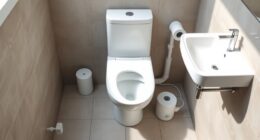Ever wondered why our toilets occasionally struggle to flush correctly? It can be quite annoying, but don’t worry! In this article, we will delve into the common reasons behind this problem and offer you practical solutions.
From clogged drainage systems and faulty flapper valves to insufficient water levels and damaged flush handles, we will cover it all.
Get ready to master the art of troubleshooting your toilet flush and bid farewell to those flushing woes.
Key Takeaways
- Clogged drainage systems, including toilet bowl cracks and sewer line blockages, can lead to improper flushing.
- The flapper valve, if faulty, can cause poor flush or water leakage.
- Insufficient water level can hinder the flushing mechanism’s pressure.
- A damaged flush handle can affect the flushing process and should be addressed.
Clogged Drainage System
When dealing with a clogged drainage system, we must address the root cause of the problem to ensure proper flushing of the toilet. One common issue that can lead to a toilet not flushing properly is toilet bowl cracks. These cracks can develop over time due to wear and tear or improper installation. When cracks occur, water can leak out, reducing the water level in the bowl and affecting the flushing power.

Another cause of a clogged drainage system is a sewer line blockage. This can happen when debris, such as toilet paper, hair, or foreign objects, accumulates in the sewer pipes, obstructing the flow of water and waste.
To effectively resolve a clogged drainage system, it’s essential to inspect and repair any toilet bowl cracks and address any sewer line blockages. By doing so, we can ensure the proper functioning of the toilet and prevent future issues.
Moving on to the next section, let’s discuss the faulty flapper valve.
Faulty Flapper Valve
To address the issue of a toilet not flushing properly, we must examine the condition of the faulty flapper valve.

The flapper valve is a crucial component of the toilet’s flushing mechanism. Its primary function is to seal the flush valve opening and prevent water from continuously flowing into the toilet bowl.
Over time, the flapper valve can deteriorate or become misaligned, resulting in a poor flush or water leakage. Regular flapper valve maintenance is essential to ensure optimal performance. This includes checking for any signs of wear and tear, such as cracks or warping, and cleaning any debris that may be affecting its functionality.
In cases where the flapper valve is beyond repair, flapper valve replacement is necessary to restore proper flushing.
Insufficient Water Level
As we continue to address the issue of a toilet not flushing properly, another potential culprit to consider is an insufficient water level.

When the water level in the toilet tank is too low, it can hinder the flushing mechanism’s ability to create the necessary pressure to flush waste down the drain effectively.
Insufficient water level may occur due to a problem with the water supply, such as a partially closed water valve or low water pressure.
To resolve this issue, check the water supply valve and ensure it’s fully open. If the water pressure seems low, it may be necessary to contact a plumber to assess and resolve any underlying water pressure problems.
Maintaining an adequate water level is crucial for the proper functioning of the flushing mechanism.

Damaged Flush Handle
The damaged flush handle can significantly impact the proper operation of a toilet’s flushing mechanism. When the flush handle is broken or the lever is damaged, it can cause problems such as a weak flush or no flush at all.
A loose handle can also lead to difficulties in flushing the toilet properly. The flush handle is responsible for initiating the flushing process by lifting the flapper or opening the flush valve. If it’s damaged or loose, it may not be able to perform its function effectively.
To rectify this issue, it’s important to replace the broken lever or tighten the loose handle. This will ensure that the flush handle operates smoothly, allowing for a proper and efficient flushing action.
Blockage in the Toilet Trap
Moving on from the previous subtopic, we can now address the issue of a blockage in the toilet trap, which can cause the toilet to not flush properly. A blockage in the toilet trap refers to an obstruction that prevents waste and water from flowing freely through the trap and into the drainage system. Here are three common causes of toilet blockages:

- Flushing non-flushable items: Flushing items like wet wipes, sanitary products, or cotton balls can lead to blockages as these items don’t dissolve easily and can get stuck in the trap.
- Build-up of mineral deposits: Over time, minerals from hard water can accumulate in the trap and narrow the passage, hindering the flow of waste and water.
- Insufficient water volume: In some cases, a low water level or poor water pressure can result in inadequate flushing force, leading to blockages.
To prevent blockages, regular toilet maintenance is essential. Here are a few tips:
- Only flush toilet paper and human waste.
- Use a plunger to clear minor blockages.
- Consider installing a water softener to reduce mineral deposits.
Frequently Asked Questions
How Can I Determine if My Toilet’s Drainage System Is Clogged?
To determine if our toilet’s drainage system is clogged, we can perform toilet tank troubleshooting. By following steps for how to fix a clogged toilet drain, we can identify and resolve any issues.
What Are the Common Signs of a Faulty Flapper Valve in a Toilet?
Common signs of a faulty flapper valve in a toilet include water constantly running, weak flush, or a toilet that won’t flush at all. To fix it, replace the flapper valve for proper functioning.
How Can I Increase the Water Level in My Toilet Tank?
To troubleshoot low water levels in the toilet tank and adjust the water level, there are a few ways. First, check the water supply valve and ensure it’s fully open. You can also adjust the float arm or the fill valve to increase the water level.

What Are the Symptoms of a Damaged Flush Handle?
When troubleshooting flush handle issues, look for symptoms of a damaged flush handle. These may include a loose or wobbly handle, difficulty in pushing or pulling the handle, or a handle that does not return to its original position after flushing.
How Can I Identify if There’s a Blockage in the Toilet Trap?
To identify a blockage in the toilet trap, we can perform toilet trap maintenance. By troubleshooting toilet flushing, we can check for signs of blockage, such as slow draining or water backup.
Conclusion
In conclusion, when dealing with a toilet that isn’t flushing properly, it’s important to consider various factors such as a clogged drainage system, faulty flapper valve, insufficient water level, damaged flush handle, or blockage in the toilet trap.
By addressing these issues promptly, one can restore the toilet’s functionality and avoid any further inconvenience.

Remember, a well-functioning toilet is the key to a smooth and hassle-free bathroom experience, so don’t let any obstacles stand in your way!










